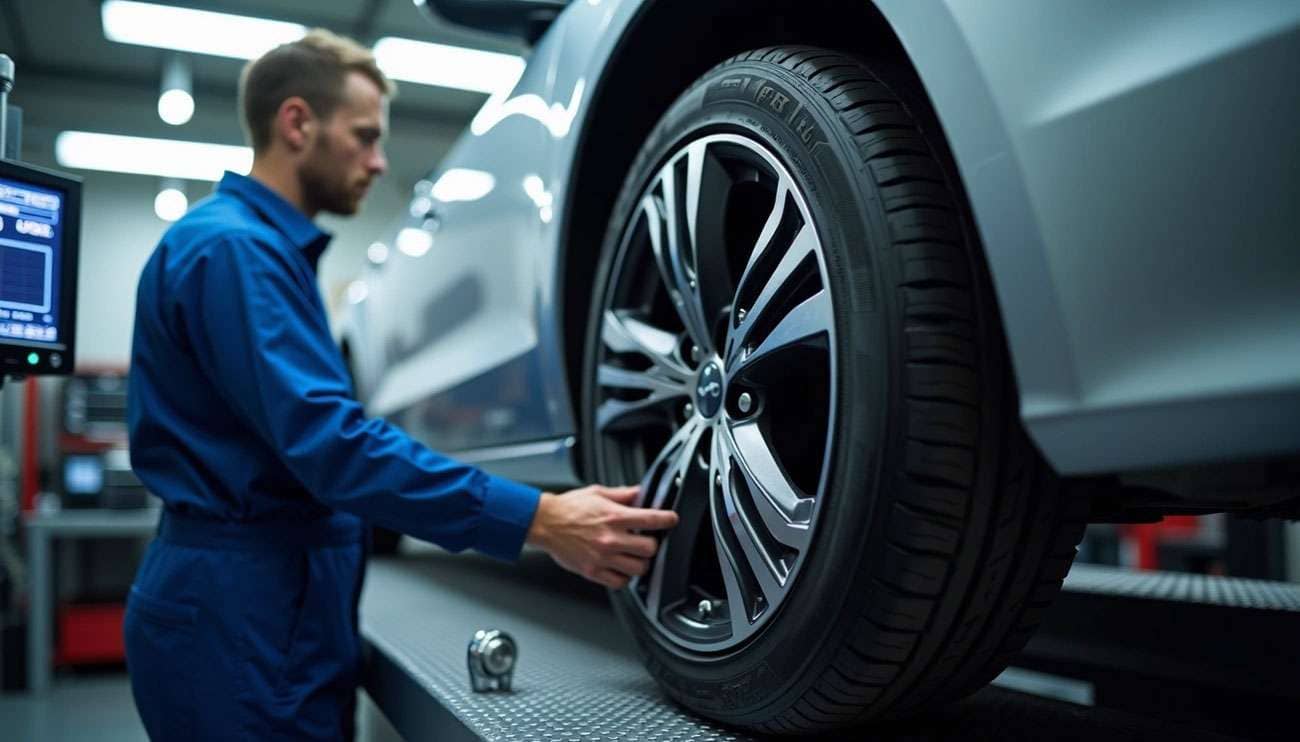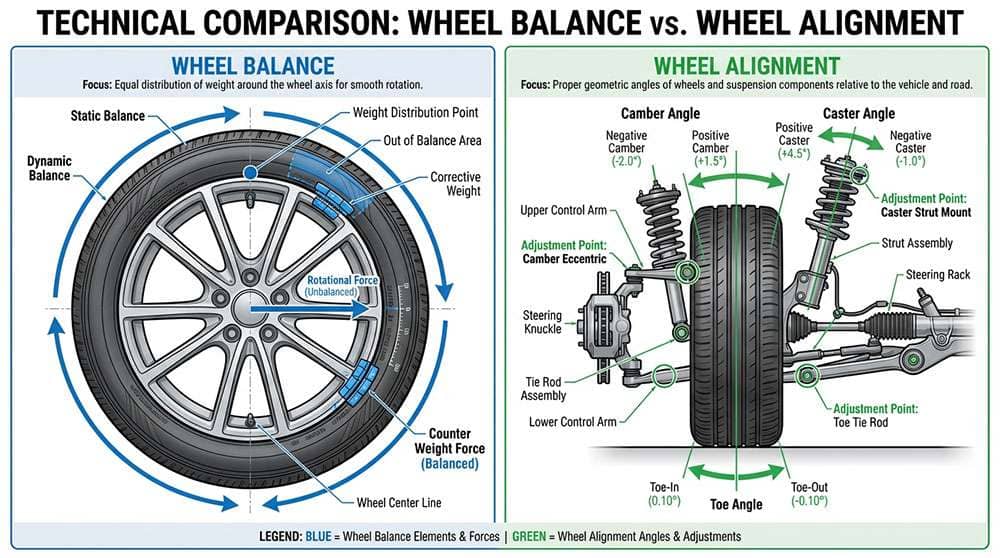
Proper tire maintenance requires checking your tire balance every 5,000 to 7,000 miles or at least once a year. Tire balancing is the critical maintenance procedure that ensures all parts of your tire and wheel assembly maintain even weight distribution around the center.
Most drivers skip this crucial service until problems develop. Unbalanced tires create uneven tread wear, reduce fuel economy, and cause annoying vibrations in your steering wheel or floorboard that get worse at highway speeds. When you neglect regular balancing, your vehicle's handling and safety suffer over time.
We'll guide you through everything about tire balancing vs alignment, explain how the balancing process works, and help you recognize the warning signs of unbalanced tires. You'll also learn the recommended maintenance schedule and discover why balanced tires deliver the smoother, quieter ride you want.

Many drivers confuse tire balancing with alignment, but these are completely different services that address distinct vehicle issues.
Tire balancing focuses on weight distribution within your wheel and tire assembly. When wheels spin at high speeds, even small weight imbalances create vibrations that you feel throughout the vehicle. Balancing technicians add precise weights to counteract these imbalances, ensuring smooth rotation.
Wheel alignment addresses the angles of your tires relative to each other and the road surface. This service adjusts three critical angles: camber (inward or outward tilt), toe (direction tires point), and caster (steering axis angle). Proper alignment ensures optimal tire contact with the road and straight-line tracking.
Balance your tires when you experience:
Routine tire rotations (every 5,000-7,000 miles)
New tire installation
Vibrations at specific speeds
Uneven tire wear in specific spots
Alignment becomes necessary after:
Hitting major potholes or curbs
Vehicle pulling to one side
Suspension work or parts replacement
Steering wheel sitting crooked while driving straight
Every 2-3 years as preventative maintenance
Unbalanced tires cause vibrations you feel in the steering wheel, floorboard, or seat. These vibrations intensify at certain speeds (typically 50-70 mph) and create premature tire wear in specific spots rather than across the entire tread surface.
Poor alignment affects your vehicle's handling and directional stability. Your car pulls to one side, requiring constant steering correction. This condition causes tires to wear unevenly across the tread (often on inside or outside edges) and reduces fuel efficiency due to increased rolling resistance.
Both services are essential for maximizing tire life, maintaining optimal handling, and ensuring comfortable rides. Neglecting either service leads to costly tire replacements much sooner than necessary.

Tire balancing is a precise procedure that extends tire life and improves your driving experience. This essential maintenance service addresses weight distribution issues that every vehicle owner should understand.
Tire balancing equalizes weight distribution around your tire and wheel assembly. Even brand-new tires have slight weight variations throughout their structure. The balancing process corrects these imbalances by adding small metal weights to specific areas of your wheels. Without proper balancing, these weight differences create vibrations that you feel while driving, particularly at higher speeds.
Consider it similar to balancing a washing machine load. When clothes bunch up on one side, the machine vibrates and shakes. Your tire works the same way - uneven weight distribution causes vibrations, accelerates wear, and stresses your vehicle's suspension components.
Technicians address two distinct types of imbalances. Static imbalances occur when heavy or light spots prevent smooth rolling, creating up-and-down vibrations. Dynamic imbalances happen when weight differences on either side of the tire's centerline cause side-to-side vibrations.
The solution involves attaching small counterweights to your wheel. These weights - typically made from environmentally friendly zinc or steel - compensate for heavy spots in the wheel and tire assembly. The goal is uniform rotation where your tire spins perfectly around its center of gravity.
Professional balancing follows a systematic process:
The technician removes your tire and mounts it on a specialized balancing machine.
The machine spins the tire at highway speeds while sensors detect any imbalances.
Computer analysis calculates exactly where weights need placement.
Small weights attach to the wheel - either clip-on weights for exposed areas or adhesive weights for concealed mounting, depending on your wheel design.
A final spin test verifies proper balance.
This calibration ensures smooth tire rotation, delivering better handling, even wear patterns, and the vibration-free ride you expect from properly maintained tires.

Your vehicle communicates when tire balancing is needed through specific warning signs. Recognizing these symptoms early can save you from costly repairs and unsafe driving conditions.
Vibrations you feel through your steering wheel, floorboard, or seat signal unbalanced tires. These vibrations typically start around 50-70 mph and get stronger as speed increases. Front tire imbalances create steering wheel vibrations, while rear tire problems cause vibrations in your seat.
Check your tires regularly for scalloped or cupped wear patterns - these wavy dips in the tread indicate balance problems. Improperly balanced tires wear prematurely in specific spots rather than evenly across the entire tread surface. Certain sections endure excessive pressure during rotation, creating these distinctive wear patterns.
Unbalanced tires create an inconsistent wobbling sensation different from alignment issues. This unpredictable movement makes your vehicle feel less stable, especially during turns or at highway speeds. Your car might sway side-to-side even on straight roads.
Unbalanced tires produce rhythmic thumping or humming noises that change with your speed. These sounds come from uneven contact between your tires and the road surface. The noises become more pronounced as the imbalance worsens and often include increased vibration.

Image Source: Barum tires
Regular tire balancing represents a fundamental aspect of vehicle maintenance that delivers significant returns on performance and safety. Here are the essential details every vehicle owner should understand.
Most manufacturers recommend balancing your tires every 5,000-6,000 miles, which aligns perfectly with routine tire rotation schedules. You should also balance your tires:
After installing new tires
Following flat tire repairs
When experiencing vibration symptoms
After hitting potholes or curbs
Skipping tire balancing creates serious problems. Unbalanced tires wear up to 50% faster on one side, dramatically reducing their lifespan. The constant vibrations also damage suspension components and wheel bearings, leading to expensive repair bills. Your vehicle's handling deteriorates progressively, creating safety hazards during emergency situations.
Most tire balancing services require 45 minutes to two hours for all four wheels. The process moves faster with newer tires or takes longer when balancing becomes necessary after road hazard damage. A standard balance at most shops takes approximately 20-30 minutes.
Yes, tire balancing is essential. Modern vehicles with lightweight composite materials and lower-profile tires face particular vulnerability to imbalance problems. Regular balancing prevents uneven wear, extends tire life, and maintains optimal vehicle handling.
Standard tire balancing service costs between $37-$55. Prices fluctuate based on location and vehicle type, with some shops charging $40-$75 when additional services like rotation are included.
Properly balanced tires represent one of the most important yet overlooked aspects of vehicle maintenance. Tire balancing goes well beyond preventing vibrations—it directly impacts your vehicle's performance, safety, and your budget.
Understanding the difference between balancing and alignment helps you make smarter maintenance decisions. Balancing addresses weight distribution problems that create highway speed vibrations, while alignment focuses on tire angles. Both services work together to maximize tire performance.
When you experience steering wheel vibrations, uneven tire wear, or thumping noises, your vehicle needs attention. These warning signs indicate problems that get worse without proper service.
We recommend following the 5,000-7,000 mile interval for tire balancing services. This maintenance step costs between $37-$55 but saves money by extending tire life and preventing suspension damage.
Balanced tires provide the smooth, comfortable ride you want while improving fuel efficiency and handling performance. Regular balancing delivers enhanced safety, better performance, and reduced long-term costs. Your tires connect your vehicle to the road—proper balancing ensures they perform at their best.
Understanding tire balancing can save you money and improve your driving experience by addressing weight distribution issues that cause vibrations and premature wear.
• Get tires balanced every 5,000-7,000 miles to prevent uneven wear and extend tire life by up to 50%
• Watch for warning signs: steering wheel vibrations at 50-70 mph, uneven tire wear patterns, and rhythmic thumping sounds
• Balancing differs from alignment: balancing fixes weight distribution while alignment adjusts tire angles relative to the road
• Expect to pay $37-$55 for professional balancing - a small investment that prevents costly suspension damage and premature tire replacement
• Don't ignore symptoms: unbalanced tires wear 50% faster and can damage suspension components, creating safety hazards
Regular tire balancing is essential preventive maintenance that ensures smooth rides, optimal fuel efficiency, and maximum tire lifespan. The modest cost of this service pays significant dividends through enhanced safety and reduced long-term vehicle expenses.
Look out for steering wheel vibrations at highway speeds, uneven tire wear patterns, and rhythmic thumping noises while driving. These are common signs that your tires may be out of balance.
Yes, tire balancing is essential. It prevents uneven wear, extends tire life, improves fuel efficiency, and ensures a smoother ride. Regular balancing can prevent costly damage to suspension components and improve overall vehicle handling.
Most manufacturers recommend balancing your tires every 5,000 to 7,000 miles. It's also a good idea to have them balanced when you rotate your tires, install new ones, or after hitting significant road hazards.
Tire balancing addresses weight distribution issues in the tire and wheel assembly, while wheel alignment adjusts the angles of the tires relative to the road and each other. Both services are important but serve different purposes in maintaining your vehicle.
The cost for tire balancing usually ranges from $37 to $55 for a standard service. Some shops may charge between $40 and $75, especially if additional services like rotation are included. Prices can vary depending on your location and vehicle type.